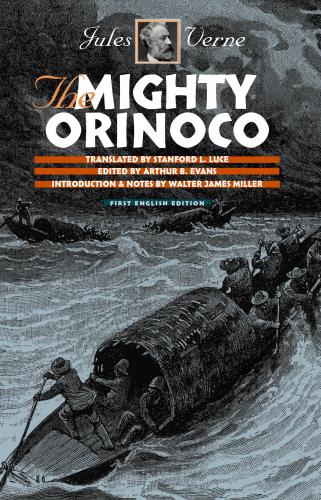“That’s also my opinion,” declared the official, “and there is no danger in returning to our homes.”
That was probable, yet only a minority of the inhabitants took the advice. Besides, the day was brightening and perhaps eyes would find an explanation of a phenomenon that ears could not provide.
For three hours the distant murmur kept increasing in a strange way. There seemed to be a kind of gliding sound, creating a powerful vibration on the surface of the entire region. Heavy and cadenced, this vibration was transmitted all the way to the right bank of the river, as though the soil had been made of peat. That the trembling could be attributed to an earthquake whose center was located in the Sierra Matapey sounded logical, and it was not the first time that the town had to contend with such a phenomenon. As for that rolling sound, like what might be produced by the matériel of an army on the march, no one could yet understand its real cause.
The official and M. Marchal, accompanied by the passengers of the falcas, walked toward the first rise of the Urbana hill, in order to observe a larger radius of the surrounding countryside.3
The sun rose into a pure sky like an enormous balloon swollen with luminous gas that the breeze had pushed toward the shores of the Orinoco. Not a cloud on the horizon, no indication that the day would be stormy. When the observers had climbed up some thirty meters, they cast their eyes toward the east.
The immense prairie appeared before them, the vast and verdant plain, that “sea of silent grasses,” following the poetic metaphor of Elisée Reclus. The surface of this sea was not calm. It must have been troubled in its depths, for, some five kilometers away, the plains were crowned with sandy swirls.
“That,” said M. Marchal, “is a heavy dust cloud; the dust of the soil is being thrown up.”
“Even so, it cannot be the wind that is raising it,” affirmed M. Miguel.
“Indeed, since it is barely blowing,” responded M. Marchal. “Could it be from small whirlwinds? No, that explanation doesn’t hold up.”
“And besides,” added the official, “there’s that continuous noise, which seems to come from heavy steps.”
“What is it then?” exclaimed M. Felipe.
And, at that moment, like a response addressed to him, a detonation was heard—the discharge of a firearm, echoing across the hill of Urbana. It was followed by others.
“Gunfire!” declared Sergeant Martial. “Those are gunshots, or I don’t know what one is!”
“They must be hunters, hunting on the plain.” observed Jean.
“Hunters, my dear lad?” responded M. Marchal. “They wouldn’t raise such a cloud of dust, unless they are an entire legion.”
There was no doubt, however, that the detonations heard came from firearms, revolvers or carbines. And one could even discern a whitish vapor, which stood out against the yellow tint of the dust cloud. More gunshots burst out. Although still distant, the sounds were easily carried to the town by the light breeze.
“To my way of thinking, gentlemen,” said M. Miguel, “we should go check out what’s going on out there!”
“And bring some assistance to those, perhaps, who have a dire need of it!” added M. Varinas.
“Who knows,” said Jean, looking at M. Marchal, “they may be my compatriots.”
“Then they must be fighting an army,” said the elderly man, “since it would take thousands of men to raise so much dust! You’re right, M. Miguel, let’s go down onto the plain to investigate.”
“And go well armed!” added M. Miguel.
This measure of prudence was indeed warranted. If Jean de Kermor’s premonition were correct, it could well be the two Frenchmen that the Indians of the area were attacking and who were defending themselves with their guns. In a few moments, everyone had regained his hut or boat. The official and a few villagers, the three geographers, Jean, and Sergeant Martial, a revolver tucked in his belt, the carbine on his shoulder, headed toward the plains, walking around the foot of the Urbana hill.
M. Marchal had wanted to join them as well; he was very impatient to find out what this was all about.
The little troop moved off at a good pace, and since the cloud remained in front of them the three or four kilometers which separated them would not take long to cover. Even at that distance, it would have been possible to distinguish human forms if the clouds of dust had not been so thick. The flashes accompanying the detonations, which were continuing, could be clearly seen and now became increasingly perceptible to the ear.
Конец ознакомительного фрагмента.
Текст предоставлен ООО «ЛитРес».
Прочитайте эту книгу целиком, купив полную легальную версию на ЛитРес.
Безопасно оплатить книгу можно банковской картой Visa, MasterCard, Maestro, со счета мобильного телефона, с платежного терминала, в салоне МТС или Связной, через PayPal, WebMoney, Яндекс.Деньги, QIWI Кошелек, бонусными картами или другим удобным Вам способом.
